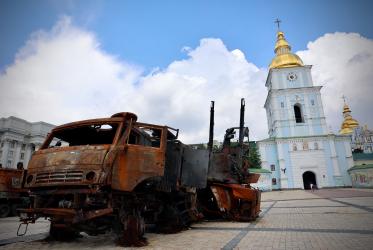Jesus the healer: 'Who Touched Me?'
Scripture: Mark 5:25-34, Mark 13:24-37
The cry for help and healing is often soft or even silent. The dignity of the person in need, the insensitivity of the wider society, our overwhelming focus on ourselves, and our relative inability to sense the pain and misery around us, makes this silence even more poignant. In the context of the 16 Days against Gender-Based Violence, this week marks the first week of Advent. In addition, World AIDS Day (December 1), the International Day for the Abolition of Slavery (December 2) and the International Day of Persons with Disabilities (December 3) are also commemorated. Women and girls continue to experience injustices disproportionately, as opposed to the wider population, further exacerbated by the HIV and COVID-19 pandemics, the plague of modern-day slavery, as well as the continuing challenges experienced by people living with disabilities.
Jesus Christ shows us with his life, teachings and actions that concern, care and compassion surpass all boundaries and can be effectively practiced even today, to bring hope and healing, to transform society.
Jesus was returning to Galilee with his disciples from the region of Gerasenes. When they sailed back across the lake (the Sea of Galilee) to Capernaum, Jesus was received by a large crowd. At the shore, Jesus was approached by a distraught leader of the local synagogue, Jarius, whose twelve-year-old daughter was dying. He pleaded with Jesus to visit his home to heal and give life to his daughter. Jesus agreed and was on his way to Jarius's house. A large number of people were accompanying him and crowding around him.
It is at this moment that, in a desperate move, a woman who had suffered from bleeding for 12 years touches the hem of the cloak of Jesus, hoping to be healed, without being identified. According to the law (Lev. 15:25-27), excessive blood flow made her ceremonially unclean. Anything or anybody she touched was considered unclean. If other people touched anything that she had touched, they too would be considered unclean. She was ostracized by society and the religious establishment. She was "self-isolating" or social distancing for 12 long years. In her attempt to find a cure to her ailment, she had spent all her resources on doctors and their therapies. Though she was desperate and impoverished, she had the faith that Jesus had the power to heal her. This conviction emboldened her to break all the rules she was subject to and risk touching Jesus' robe. She was healed instantaneously.
At that moment, amid the jostling crowd, Jesus asks, "Who touched me?" His disciples were with him and in close contact with him. Many people were touching him, physically and socially. But only one person truly touched him. She touched in faith - faith in Jesus and in the power of God to free her. She touched in hope - hope for healing and liberation from isolation and poverty. She touched with courage - the courage to break the unjust laws and rituals of the establishment.
Jesus responded with love, expressed in three ways.
- Jesus acknowledged the presence of the unnamed, ostracized, and sick person, who probably was considered the least among the crowd.
- Jesus appreciated the agency of the person by highlighting her role in the healing. ("Daughter, your faith has healed you," v.34a)
- Jesus answered her quest for healing, freed her from suffering, and gave her peace (v.34b)
Today Jesus continues to breach barriers between the unnamed and named, distance and proximity, men and women, rich and poor, disease and well-being, death and life. Dismantling the barriers with faith, hope, courage and, most of all, love!
This Advent, as we stand firm, waiting on the Lord, alert and awake:
How can we, as followers of Jesus, be responsive to the need for justice that surrounds us?
How can we be touched by and touch others in need?
Dr Manoj Kurian, coordinator of the WCC-Ecumenical Advocacy Alliance
The impressions, hopes and ideas expressed in this reflection are the contributions of the author and do not necessarily reflect the opinion or policies of the World Council of Churches.





